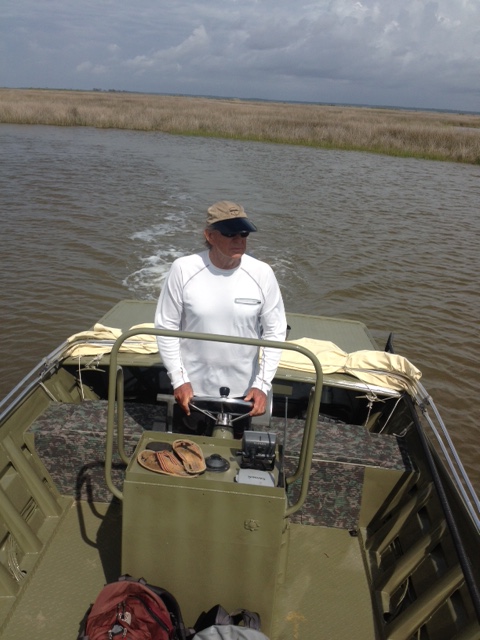
by Rick O'Connor | Dec 17, 2021
Recently I watched a documentary on TV entitled The Loneliest Whale; the search for 52. The title grabbed my attention and so, I checked it out.
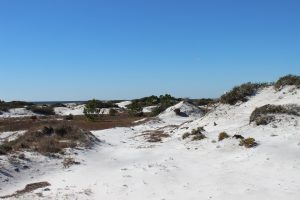
There are many forms of wildlife that are very hard to find in our area. But we continue to look.
Photo: Rick O’Connor
Seems a decade or so ago the U.S. Navy was doing SONAR work in the Pacific between Washington and Alaska and detected a strange sound coming in at 52 hertz. They had not herd this before and would continue to hear it in different locations around the northern Pacific. Their first concern was it was something new from the Russians, but when they showed the graphs and played the recording to a marine mammologist named Dr. Watkins, they found that it was most likely a “biological” – mostly likely a whale.
The problem was that Dr. Watkins had never heard whales calling at 52 hertz. If it was a whale, it was calling a lot – but no other whales were answering. Hence the name “the loneliest whale”. If it was a whale, and no others would talk to it, it was kind of sad. But who was this whale? What kind was it?
Word of the loneliest whale spread around the world and many humans made a connection to this animal, possibly because of their own disconnect with their own species. Stories and ballads were written, and people began to feel for the poor animal that apparently had no friends.
This story caught the attention of a documentary film maker who was interested in finding “52”, as the whale became known. He solicited the help of other marine mammologists; Dr. Watkins had died. According to those marine mammologists, this was going to be VERY difficult. It is hard enough to find just a pod of whales in the open Pacific, much less a specific pod with a specific individual. But they were excited about the challenge of finding this one animal, “52”, and off they went.
As I was watching this documentary it reminded me of my own search here near Pensacola. In 2005, I was asked by members of state turtle groups if I could search to see if diamondback terrapins lived in the western panhandle. This turtle’s range is from Cape Cod Massachusetts to Brownsville Texas, but there were no records from the Florida panhandle. Did the animal exist there? I was running the marine science program at Washington High School at the time and thought this would be a good project for us. So, we began.
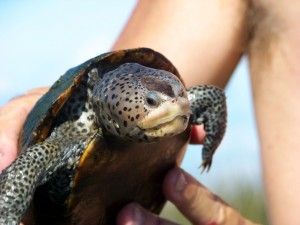
Mississippi Diamondback Terrapin (photo: Molly O’Connor)
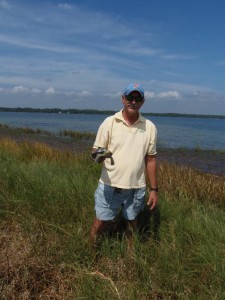
This small turtle can be held safely by grabbing it near the bridge area on each side.
Photo: Molly O’Connor
The students researched terrapin biology and ecology to determine the locations with the highest probability of finding, and we searched. I quickly found that the best time to search for terrapins was during nesting in May and June, and that the worst time to do a project with high school seniors was May and June. So, the project fell on my wife and me. For two years we searched all the “good spots” and found nothing. We placed “Wanted Poster’s” at boat ramps near the good spots with only calls about other species of turtles, not the terrapin.
Then one day in a call came in from a construction worker. Said he had seen the turtle we were looking for. For over a year we had been chasing “false calls” of terrapins. So, I was not overly excited thinking this would be another box turtle or slider. I asked a few questions about what he was looking at and he responded with “you’re the guy who put the wanted poster up correct? – well your turtle is standing next to the poster… it’s the same turtle”. Now I was excited. We did some surveys in that area and in 2007 saw our first terrapin! I can’t tell you how exciting it was. Two years of searching… at times thinking we might work on another project with a different species that actually exists… reading that the diamondback terrapin is like the Loch Ness monster – everyone talks about them, but no one has ever seen one. And there it was, a track in the sand and a head in the water. Yes Virginia… terrapins do exist in the Florida panhandle. The excitement of finding one was indescribable.
We were hooked. We now had to look in other counties in the panhandle, and yes, we found them. As I watched the program of the marine mammologists searching for “52” I could completely relate.
Today, as a marine educator with Florida Sea Grant, I train others how to do terrapin surveys and searches. I let them know how hard it is to find them and to not get disappointed. When they do see one, it will be a very exciting and fulfilling day. Our citizen science program has expanded to searching for other elusive creatures in our bay area. Bay scallops, which are all but gone however we do find evidence of their existence and spend time each year searching for them. In the five years we have been searching we have found only one live scallop, but we are sure they are there. We find their cleaned shells on public boat ramps – by the way, it is illegal to harvest bay scallops in the Pensacola Bay area. Another we are searching for is the nesting beaches of the horseshoe crabs. This is another animal that basically disappeared from our waters but are occasionally seen now. It is exciting to find one, but we are still after their nesting beaches and the chase is on.
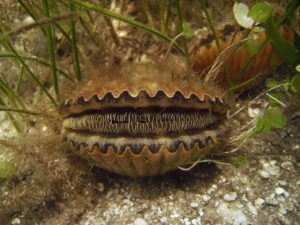
Bay Scallop Argopecten irradians
http://myfwc.com/fishing/saltwater/recreational/bay-scallops/
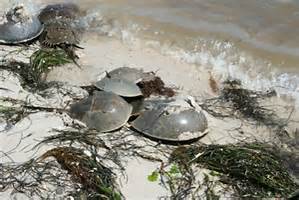
Horseshoe crabs breeding on the beach.
Photo: Florida Sea Grant
I love the challenge of searching for such creatures. If you do as well, we have a citizen science program that does so. You can just contact me at the Escambia County Extension Office to get on the training list, trainings occur in March, and we will get you out there searching. As for whether they found “52”, you will have to watch the program 😊
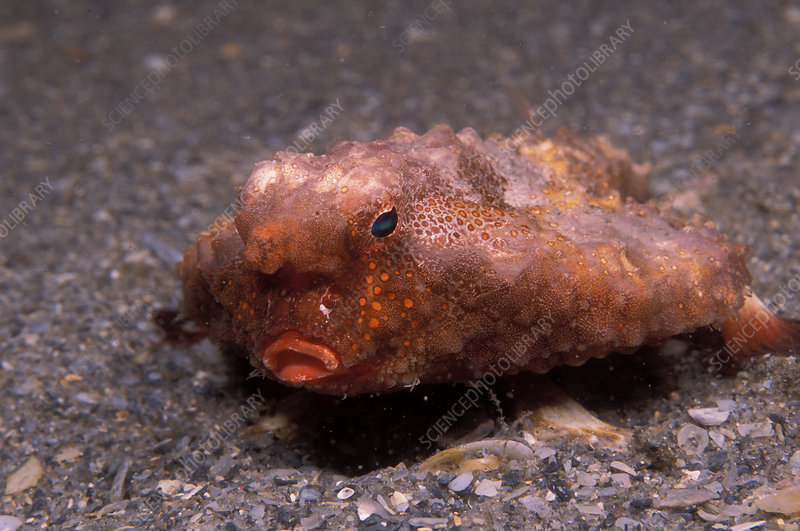
by Rick O'Connor | Dec 17, 2021
This is another one of those fish in this series that is not often seen but when you do see one you will ask “what is that?” – So, we will answer the question by including it here.
Like the frogfish we have already written about, batfish are described by Hoese and Moore1 as “grotesque” and they take it a step further by telling us all “ugly” fish (as they say) are grouped into what many call “dogfish”. As with the frogfish, I am not sure I would use the term grotesque, but they are strange looking.
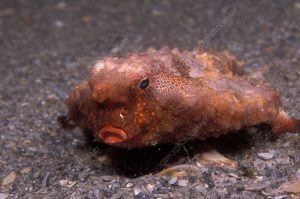
Juvenile Polka-Dot Batfish (Ogcocephalus radiatus) in the polluted intracoastal waterway in Palm Beach County, FL.
Photo: Science Photo Library
I have only seen a couple in my life. Hoese and Moore mention they are often brought up in shrimp trawls, and I have seen them while doing trawl surveys at Dauphin Island Sea Lab. I also found one while snorkeling along a seawall near Gulf Breeze FL. So, they are out there just not encountered as often, or as well known, or seen as frequently, as many other fish in the Gulf. Another reason to include this group here.
It is hard to describe what this fish looks like. They are, as they say, dorso-ventrally flattened – meaning from top to bottom, not side to side – like a stingray. They have two fins extending from parts of their body that sort of “stick out of the side” and appear to be like webbed feet with which they walk. Actually, there are these small, modified fins on the ventral side that are used to walk on the bottom – they are bottom dwelling (benthic) fish for sure. Like their relatives the frogfish they have a modified spine that is used like a fishing lure. Like the frogfish, the shape of that lure can be used to identify species. But unlike the frogfish the lure is located between their mouth (which near the bottom of the body and is very small) and a pointed rostrum that extends from the top of their head like a battering ram. This lure is extended to lure not fish swimming above, as with the frogfish, but small creatures in and on the sand. Because of this they do not call the lure an illicium but a esca. These are strange looking fish.
Hoese and Moore list four different species and indicate there are at least three others in the Gulf of Mexico. Most are associated with the continental shelf of the Gulf and not inland where we might see them snorkeling around. A couple of species are more associated the continental slope, which drops from the continental shelf to the deep sea. But the Polka-dot batfish (Ogocephalus cubifrons) is reported as being inshore and is the species I have encountered.
Many species are only described as being from the shelf of the Gulf of Mexico and no other oceans. Some of them are even more restricted to either the eastern or western Gulf. This all suggests that batfish do have biogeographic barriers of some sort restricting their dispersal. Being offshore benthic fish, your first guess would be substrate. Usually in those locations the temperature and salinities are pretty similar but the material on the bottom (rock, shell, sand, canyons, etc.) are not. However, several articles mention that batfish can be found over rocky or sandy bottom2,3,4 and the polka-dot batfish can be found in grassbeds as well2. So, I am not sure what the possible barrier is, but several do have a limited range. The east-west split could very well be the DeSoto Canyon off the coast of Pensacola.
All of that said, it is a very interesting group of fish that for one species you might encounter while out and about snorkeling or diving in the Florida panhandle.
References
1 Hoese, H.D., Moore, R.H. 1977. Fishes of the Gulf of Mexico; Texas, Louisiana, and Adjacent Waters. Texas A&M Press. College Station, TX. Pp. 327.
2 Ogocephalus cubifrons, Polka-dot batfish. 2017. Discover Fishes. Florida Museum of Natural History. https://www.floridamuseum.ufl.edu/discover-fish/species-profiles/ogcocephalus-cubifrons/.
3 The Red-lipped Batfish. 2014. Ashland Vertebrate Biology. Ashland University, Ohio. http://ashlandvertbio.blogspot.com/2014/12/the-red-lipped-batfish.html.
4 Cocos Batfish, Ogocephalus porrectus. 2015. Smithsonian Tropical Research Institute. https://biogeodb.stri.si.edu/sftep/en/thefishes/species/777.
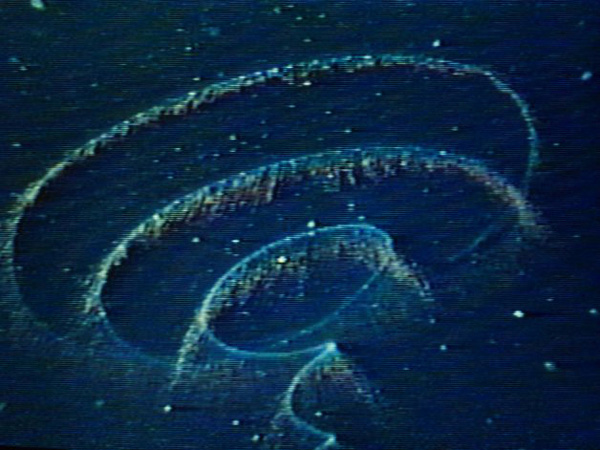
by Rick O'Connor | Dec 10, 2021
Most people would agree that this is one of the best times of the year. Christmas brings great music, great cooking, great family gatherings, and… great lights. The lighting of Christmas is one of the more beautiful parts of these celebrations and as I thought about Christmas and writing about nature I thought of those lights.

There is nothing like Christmas lights on a tree.
Photo: Molly O’Connor
Nature can produce beautiful lights as well. Mostly found in the ocean – “phosphorus”, as many called it when I was growing up here, is a beautiful spectacle. It is hard to see with our artificial lights but in the warmer months of summer at locations far from the artificial lights of people, the sea glows a blue-green color that is amazing. Many see this light as sparkles in the water as the waves roll by. Others see it as a stream of light as a fish, or something else, moves around. In the right conditions, you can see your footprints glow as you step in the wet sand. I remember diving at night under the Bob Sikes Bridge once in the 1970s when the bridge, and all of the divers, were aglow. It was beautiful. This phenomena have amazed scientists for centuries and trying to understand how it is produced was a quest for many.
The term phosphorescence actually means using light to emit light. Turns out that is not what is happening in this case. Scientists found that some creatures posses a group of molecules known as luciferins. The term lucifer means “producing light” or “morning star” and seemed an appropriate name for this group of molecules. When luciferin is oxidized, the transfer of an electron emits a “cool light” – usually blue-green in color. Cool meaning that less than 20% of the emitted light is lost as heat. There is a catalytic enzyme known as luciferase that can increase the speed of this chemical reaction and produce bright light in seconds. Since this light is produced by a chemical reaction it was called “chemiluminescence”. However, since this reaction is produced and controlled by living organisms is more widely known as “bioluminescence”. It is not phosphorescence.

Bioluminescence in the sea.
Photo: North Carolina Sea Grant
There are many creatures that produce bioluminescence. The famous fireflies are one, but most live in the sea. The “phosphorus” we are used to seeing is produced by small single celled plants in a group known as dinoflagellates. When disturbed they emit blue-green light as a flash and then a slow dim. Fish swimming past, waves crashing on the beach, or boat and propeller pushing through the water will disturb them. The warmer the sea, the more dinoflagellates there are, the more amazing the light show is. There are lagoons in the tropical parts of the world where these small plants are trapped due to a small opening in and out of the lagoon. The entire lagoon can light up when the conditions are right.

Noctiluca are one of the dinoflagellates that produce bioluminescence.
Photo: University of New Hampshire.
But it does not stop with dinoflagellates. As you descend into the deep ocean the bioluminescence becomes even more spectacular. All sorts of creatures from jellyfish to squid, to fish, to even fungus and bacteria illuminate. Some species of luminescent marine animals do not produce the light themselves but rather harbor luminescent bacteria on the skin or specially designed skim pockets to hold them. Though blue-green is the dominant color, yellows, oranges, and reds have been produced. It has been suggested that blue-green is much easier to see in the deep so reds and oranges are less likely. That said, it is believed that some marine creatures will produce those colors to assist in capturing prey. They can see the red light, but their prey cannot.

The magical lights of the deep sea.
Photo: NOAA
Either way the illumination of the ocean, like the Christmas illumination of our streets and homes, is beautiful and amazing thing. As you admire the lights on the neighborhood home, find some short videos of bioluminescence online and enjoy the show. Happy Holidays everyone.

by Laura Tiu | Dec 2, 2021

Florida Master Naturalist Student and Florida State Park Ranger, Bruce Williams, prepares for his snowy plover lesson.
There is an oft quoted proverb “those who can’t do, teach.” It is meant to be humorous, but it couldn’t be farther from the truth. Teachers of all kinds have enormous impacts on our lives. For graduates of the Florida Master Naturalist Program (FMNP) there is a line in the mission statement that reads “The FMNP teaches those who teach others about Florida’s unique ecosystems and wildlife.” In fact, to graduate, FMNP students must complete a project and present, or teach, it to the class.
A good teacher, like a good entertainer first must hold his audience’s attention, then he can teach his lesson (John Henrik Clarke). In a recent coastal class, we had the good fortune of having a State Park Ranger as a student. His job requires him to do interpretive education at the park, so he had quite a bit of experience under his belt. His project, a craft project involving the assembly of a cute snowy plover chick, was his way of holding his audience’s attention while he talked of the importance of preserving and protecting habitat for shorebirds.
I thought the project and message was impressive and worthy of sharing. To all of you teachers out there who work to make our lives and world better, thank you, and here is another great activity to add to your quiver. If you would like more information on the Florida Master Naturalist Program go here: https://masternaturalist.ifas.ufl.edu.

Making cotton ball snowy plover chicks
Group Project: Make a Snowy Plover Chick (Peipert, 2011)
This project is suitable for Elementary age through Middle school age children. It is recommended when doing project with a class or large group that some preparation is done ahead of time.
Supplies:
corrugated cardboard (disassembled brown packing box will do)
1 bag of cotton balls
1 container of black glass beads (sold at craft stores)
black sunflower seeds
1 container of wood toothpicks (kind with one end blunt)
1 can of black spray paint
several of each black, brown & gray markers
several bottles of quick dry tacky glue (sold at craft stores)

Cotton ball snowy plover chick craft
Preparation:
- Using an exacto or carpet knife and T-square cut corrugated cardboard into 3”x3” squares for the # of stands needed. To complete stand preparation, write Snowy Plover chick on stand, draw a pair of feet in center of stand and pierce cardboard in center of feet. This step is a real time saver and recommended for young children.
- Paint toothpicks with black spray paint for legs, easiest way to do this is by taking toothpicks and sticking them into a spare piece of cardboard upright them paint.
Instructions: (skip to instruction #3 if using stands with feet & holes premade)
- Draw a pair of bird feet on center of cardboard and if you want write” Snowy Plover chick” on cardboard.
- Use the pointed end of a toothpick to make a hole in the center of drawn feet. Then put the blunt end of toothpicks in the holes and put a heavy glob of glue around them. Don’t be shy with the glue, it will dry clear and will be better support.
- Take one of the cotton balls and roll around between hands to make it smaller. This will be the head. Next using all three or two markers make many dots on one side of both cotton balls creating a speckled pattern.
- Put a glob of glue at top of each toothpick and put larger cotton ball (the body) on top of toothpicks pushing down so the glue is covered by the cotton ball. Next put a glob of glue on the top of body and put white side of cotton ball (the head) on glue.
- To complete the chick put a small glob of glue on opposite sides of head then place glass beads on. Lastly put a glob of glue on side of head that the feet are facing forward and place sunflower seed on with the pointed end facing out.
- Let stand for at least 15 minutes to dry before handling.
- Enjoy your Snowy Plover chick creation!

by Rick O'Connor | Dec 2, 2021
This series on vertebrates of the Florida panhandle is to enhance your education of the different animals that call this place home. This is the only reason to include clingfish to this list… to enhance your education.
There are about 500 species of fishes in the northern Gulf of Mexico. We I began this series I had no intention of writing about all of them. I was going to focus on the more common and familiar, such as snappers and mackerels. Things like the clingfish were to be skipped over. But when I saw this family next on the list, I could not skip over this one. You see, this is actually a pretty common fish that you many have already encountered and followed by asking “what kind of fish is this?” So, we will include our friend the clingfish.

Clingfish
Photo: University of Washington
It belongs to the family Gobiesocidae and, in the northern Gulf of Mexico, there is only one resident species, Gobiesox strumosus, known as the clingfish or skilletfish. They are called this because their body shape resembles a cast iron skillet, roundish head with an extended tail and dark in color. The often-used clingfish name comes from the sucker apparatus they form on the ventral side of their body to cling to rocks and inside of shells – where they are most often found. Hoese and Moore1 report only one species from the northern Gulf but suggest there could be more on the offshore reefs.
The local skilletfish is reported to reach a mean length of three inches. I have only seen a few of these and the ones I found were smaller than this. They are dark in color, often with stripes or streaks, and can be all black – the ones I have found were all black. The ones I have found are inside dead oyster shells associated with oyster reefs. You may find a random oyster clump on the bottom. You just pick it up, look inside the opened shells and open the dead shells, and you may find one. They have been reported associated with rocks, pipes, and other structures on the bottom.
This species does have a large geographic range, suggesting few barriers to dispersal. They are found from New Jersey to Brazil and throughout the Gulf of Mexico.
There is no commercial value for the animal, no cool natural history facts, just an small fish that you may come across while playing in the Gulf that you might ask – “what kind of fish is this?” Now you know, it’s the clingfish.
Reference
1 Hoese, H. D., Moore, R.H. 1977. Fishes of the Northern Gulf of Mexico; Texas, Louisiana, and Adjacent Waters. Texas A&M Press. College Station TX. Pp. 327.



















